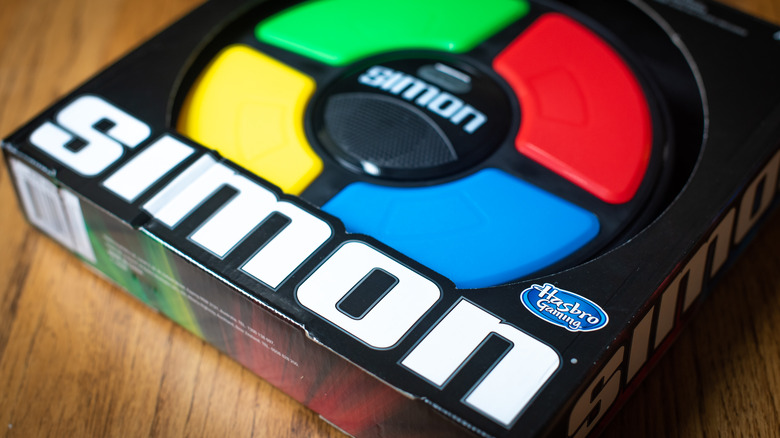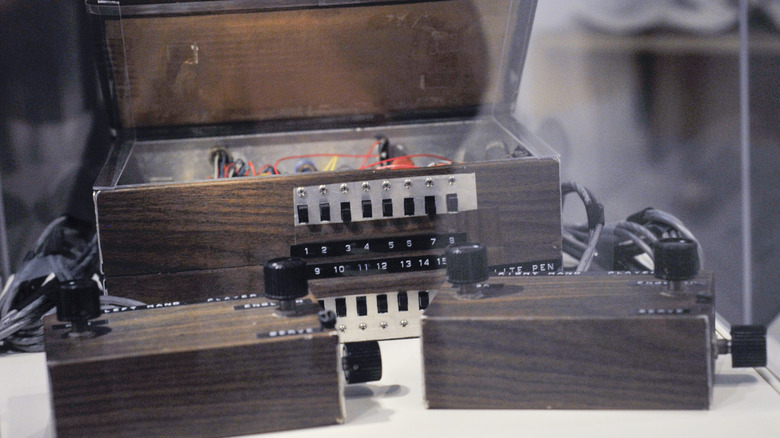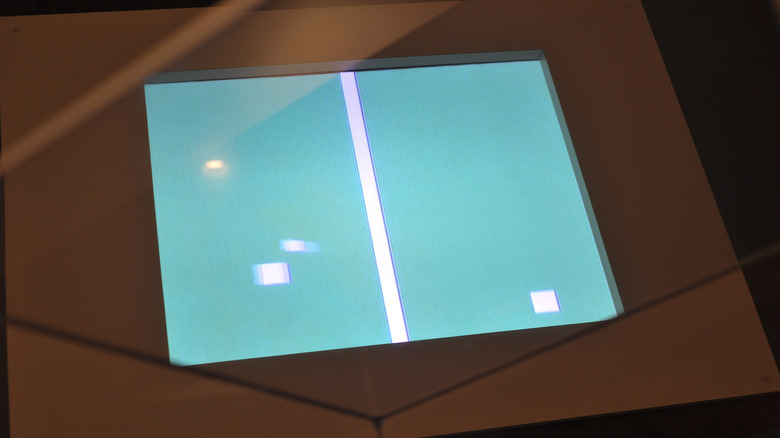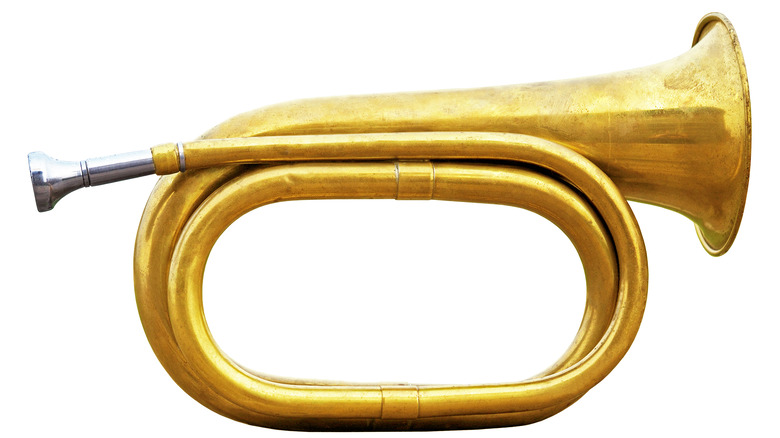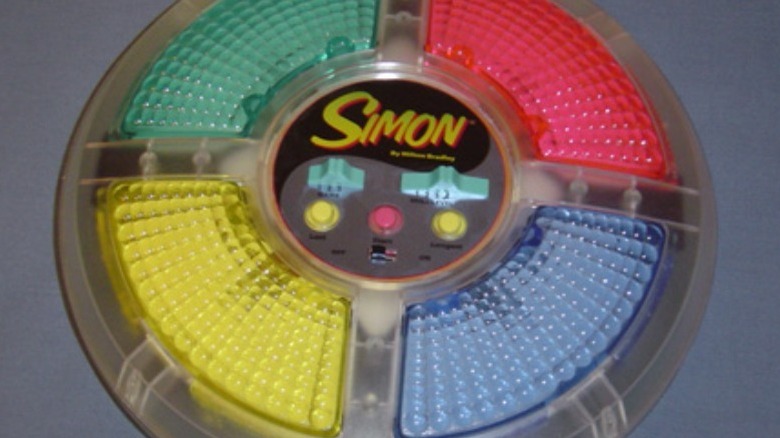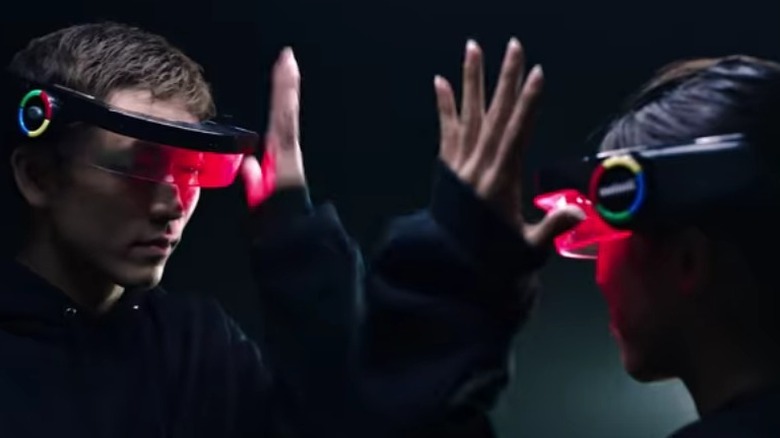What Happened To The Simon Toy?
In 1977, toy developers Ralph H. Baer and Howard J. Morrison were named as the inventors on patent number US4207087A, filed on behalf of Marvin Glass & Associates, as published by Espacenet. The application for the "microcomputer controlled game" described the game play as taking place either between two players or one player versus the game itself as "the machine generates a random sequence of tones which must be accurately repeated by the participant. The machine then repeats the latest sequence and adds another tone to the sequence. The process is repeated until the participant makes an error, or until the sequence reaches a predetermined length." This was how Simon, the game that ushered in the age of computer gaming, came to be. It made toy and gaming history.
Per Smithsonian magazine, Simon, named for the classic analog game of Simon Says, in which players copy a leader's movements until making a mistake, made its public debut when the Milton Bradley Company introduced the game on May 15, 1978 via a promotion held at the uber-trendy disco Studio 54 in New York City. Just as Studio 54 was not the first of its kind but became the best known and the standard-bearer of '70s discotheques, Simon was not the first electronic memory game, but it improved upon past iterations and introduced computer gaming to the mainstream American public.
Ralph H. Baer was an electronic gaming pioneer
Simon was not Ralph H. Baer's first foray into electronic gaming. As reported by gaming site 1Up, in May 1972 Baer's Magnavox Odyssey premiered at a Magnavox exhibition in Burlingame, California. Also known as the "brown box" (shown above), the Odyssey was a console hooked up to a television that allowed players to play an electronic version of ping pong via turning knobs and watching the screen. Engineer Nolan Bushnell observed what the Odyssey was doing and commissioned an improved version of the ping pong game. This went on to be "the first video game," Pong, which appeared as an arcade game and launched Atari.
Magnavox attempted to sue Bushnell and Atari for infringing upon Baer's patents, but Atari simply licensed the patents for $100,000 in 1976. Baer later wrote in his 2005 book "Videogames: In The Beginning" that he kept his "mouth shut when Nolan was getting his face in front of the cameras. In subsequent years, it would increasingly bug me to hear Nolan referred to as the 'inventor' of videogames."
Baer improved upon Atari's Simon Says attempt
Despite having his version of what was later marketed as Pong (shown above) stolen and credited to Atari, Ralph Baer wasn't done with electronic games. As reported by 1Up, in 1976 he was able to get a specific type of revenge on Atari. Baer attended the Music Operators of America trade show in Chicago, Illinois, which by then included coin-operated arcade games. He noticed an Atari product called Touch Me, an electronic version of Simon Says that had been released in 1976 but failed to take off. Baer played the game with his associate Howard Morrison and later said of the experience, "Nice gameplay. Terrible execution. Visually boring. Miserable, rasping sounds." Baer and Morrison returned to their homes in New Hampshire and set about making their own, improved version of Touch Me, which they referred to as Follow Me.
Baer pitched his prototype to Marvin Glass & Associates, an independent toy design company he'd worked with in the past. After getting the go-ahead to proceed, Baer and Morrison brought in Lenny Cope to program Follow Me, later noting, "Lenny made steady progress encoding the ever-growing list of changes Howard Morrison and I laid on him." Another Follow Me improvement included creating a four-tone generator with the new TMS 1000 microprocessor. This was a low-power, low-cost chip from Texas Instruments that made possible a wide range of new electronic toys that came to market in the 1970s.
Simon's distinctive tones were modeled on a bugle
Follow Me's distinctive, pleasant tones that accompany the flashing lights' patterns were another improvement over Atari's harsh Touch Me tones. Per 1Up, Baer knew that the tones would make or break the game and started research with the help of his son's "Compton's Encyclopedia" to find an instrument that could play a variety of songs using just four tones. He happened across the standard bugle (shown above), a horn that relies entirely on the musician's mouth movements, or embouchure, to produce different notes. "Henceforth, our game was programmed to beep G, C, E, and G — the bugle sounds that can be played in any sequence and still sound pleasant," remembered Baer.
Baer and Morrison patented their creation before pitching the prototype again, this time to toy manufacturing kingpin Milton Bradley, who snapped it up and renamed it Simon. After the release at Studio 54, Simon went on the market for $24.95 and became one of the hits of the 1978 Christmas shopping season. 1Up theorizes that some of Simon's popularity may have come from the toy's tones' similarity to those from the hit movie released in 1977 "Close Encounters of the Third Kind," which also featured a distinctive set of tones as part of the plot in which aliens and a human man learn to communicate with each other.
There's nothing quite like Simon
Per Fast Company, Simon was such a hit that many copycat products soon followed, including a handheld version of Atari's original Touch Me game, Castle Toy's Einstein, and Tiger Electronic's appropriately named Copycat. Other companies attempted to incorporate Simon-like games into electronic devices with multiple game options, including Merlin from Parker Brothers and Fabulous Fred from Mego. By the end of the 1980s, all of them had vanished from store shelves and Simon alone remained. In fact, after Hasbro acquired Milton Bradley in 1984, they went on to offer a variety of Simon offshoots and sequels that continue to utilize technological advances in new versions of the classic Simon game.
In 2000, Hasbro introduced the double-sided Simon2, or Simon Squared (featured in a YouTube video) which offered a total of seven Simon games, three on the traditionally designed side and four on the new side, which incorporated eight beeping, flashing buttons. Simon Sticks made its way to the market in 2004 and per the directions sheet from Hasbro, is played with a pair of elongated controls that resemble drumsticks and require players to shake and cross the sticks to respond to Simon's lights and tones in the correct order. The original Simon game got a revamp itself in 2005 (shown above).
Simon continues changing with the times
As reported by Fast Company, other Simon spinoffs include 2005's Simon Trickster, which added three gameplay options but was ultimately discontinued, per Hasbro senior director of marketing Jennifer Boswinkel, who said Trickster "stretched the gameplay from the core essence of Simon a bit too far." In 2011, Hasbro introduced Flash versions of Simon as well as Yahtzee and Scrabble, incorporating handheld blocks with which players played Simon Shuffle by rearranging the blocks to fit an original color order and Simon Lights Out, which requires rearranging the blocks until the lights are all shut off.
From 2012 on, Hasbro has, according to Boswinkel, focused on combining nostalgia for older games with new technologies, for which Simon appears to be a perfect product. Newer game versions include Simon Swipe, in which the classic colorful buttons are now swipeable; the direction of the swipe is part of the game. Unlike the original Simon, Simon Swipe (as seen on YouTube) isn't meant to be played on a table and instead is meant to change hands during group play. Said Boswinkel, "we made [Swipe] more pass-around from the insight that people want to gather and play together." Other new versions include Simon Air, in which the push buttons are completely gone and players must replicate patterns via placing their hands near lights, and Simon Optix (shown above and as seen on YouTube), which introduced the first wearable Simon with which lights flash before players' eyes via a visor and patterns are copied manually in the air.
